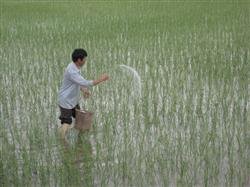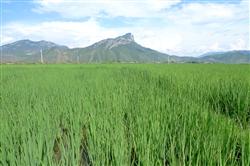How to manage the later stage of rice growth?

How to manage the later stage of rice growth? What should I pay attention to? In the later stage of rice growth, it is especially necessary to prevent premature senescence. Premature senescence occurs in rice from heading to maturity, which will lead to poor grain filling, increase of blighted grain and decrease of yield. There are many factors leading to premature senescence in the later stage of rice growth. First, improper cultivation and management. The planting density is too high, the plant growth is weak; in the early and middle stages, the application of nitrogen fertilizer is too much, the application of phosphorus and potassium fertilizer and trace element fertilizer is insufficient, the aboveground growth of the plant is too prosperous, the leaves are weak, the field is shaded, and the lower leaves die in advance; at the same time, the root growth is seriously hindered, the new roots are few and short, and the ability to absorb nutrients is weakened, resulting in premature senescence. In the case of long-term flooding and lack of fertilizer, premature senility is also easy to occur. Second, the soil is anoxic and hardened. In the land with low-lying terrain, high groundwater level, poor permeability and strong reducibility, there are many anoxic and toxic reducing substances in the soil, which reduces the root activity of rice, causes poor root development, blackening and rot, and loses the ability to absorb nutrients, resulting in early senescence of roots and leaves. Soil consolidation, poor permeability, poor root development of rice, and premature senescence due to lack of nutrients in the later growth stage. Third, adverse climatic conditions. The influence of adverse climate such as low temperature and cold wave in autumn will hinder the physiological activities of rice roots and leaves and cause premature senescence. Especially when Cold Dew wind comes earlier, rice is more likely to have premature senescence. During the grain filling period, the temperature was too low or the sunshine hours were too few, and the formation and transfer rate of assimilation substances slowed down. In September, rice encountered a low temperature of 5-6 ℃, resulting in discoloration and premature senescence of varieties with poor cold tolerance or plants with poor root system development. The fourth is the factor of variety. Generally short-stalked and precocious rice varieties are prone to premature senescence. The premature senescence of rice has a great effect on the yield, so measures should be taken to prevent it as soon as possible. (1) Scientific irrigation. Long-term flooding irrigation is strictly prohibited in the later stage of rice growth, wet irrigation should be put off, intermittent irrigation and alternation of dry and wet should be achieved in order to enhance root activity and prolong the functional period of leaves. Prevent the water from being cut off too early, advocate old-age rice, raise roots and protect leaves. In the heading and flowering stage and filling stage, there is a shallow water layer in the field in normal weather. in case of continuous high temperature, the method of daily irrigation and night drainage is adopted to prevent premature senility. For the fields with heavy clay and poor permeability, the fields should be irrigated intermittently in the later stage, that is, shallow water should be irrigated once, and then irrigated after 2-3 days of natural drying. (2) improve the soil. For low-lying land or saline-alkali land, timely trench drainage, improve soil permeability, and apply a large amount of high-quality farm manure at the same time. For the paddy field with soil consolidation, increase the number of ploughing, loosen the soil, enhance the aeration capacity of the soil, and promote the rice to take root and absorb nutrients. (3) rational fertilization. For paddy fields that are short of fertilizer and early senescence, grain fertilizer or extra-root topdressing can be applied at heading stage. 100 grams of potassium dihydrogen phosphate and 50 kilograms of water per mu are sprayed once every 5 to 7 days. For the lack of trace elements of rice, only need to spray once. Fertilizers should be applied to the paddy fields with heavy yellowing in the later stage and the sandy soil with poor fertilizer conservation. Generally, 2kg of urea and 2kg of potassium chloride are applied per mu, while 15 grams of potassium dihydrogen phosphate and 50kg of water are sprayed per mu. Click to get more rice planting techniques click to get more food crop planting techniques
- Prev

What matters should be paid attention to when applying fertilizer to rice?
What matters should be paid attention to when applying fertilizer to rice? Please introduce that the principle of fertilization for rice should be organic fertilizer and phosphate fertilizer as base fertilizer, potassium fertilizer as tiller fertilizer, nitrogen fertilizer applied evenly for many times, pay special attention to strong bud and strong seed fertilizer, attack large panicle and big grain at the same time. (1) the base fertilizer is mainly organic fertilizer.
- Next

How to dry the rice field?
How to dry the rice field? Rice drying is an important measure to improve the soil structure of paddy field, promote the root system of seedlings, enhance the root activity of rice, improve the tenacity and lodging resistance of rice stalk, control ineffective tiller, increase panicle rate, improve field microclimate and reduce the occurrence of rice diseases and insect pests. But...
Related
- The first cup of black tea in spring, the flavor and history of tea gardens in Kenya, Africa
- The computer can not only choose potatoes, but also grow tea rice. AI will grow winter oolong tea champion.
- It is not only the inflated tea bitten by insects, but also engraved with the four seasons tea in Beipu.
- The Oriental Beauty Tea Festival in Zhuxian County takes the stage at the weekend to experience the plus-size feast of oil tea.
- & quot; Oriental Beauty Tea & Exploration of Emei in Hsinchu, the hometown of quot;
- The new variety of strawberry "Tainong 1" dessert is the first choice with mellow aroma. Crimson gorgeous
- History of Tea in Taiwan: from Wild Inner Mountain to Export Tea Garden
- Two types of Taiwan Oriental Beauty Black Tea won the British three-Star Award for Childhood Tea Xiang Zhang Jiaqi changed from pilot to champion tea maker.
- Banana species and varieties: the planting history of Taiwan Xianren banana and dwarf banana is long, is banana disease resistant?
- Coffee planting Technology: Qianjie Coffee from Seedling to harvesting

